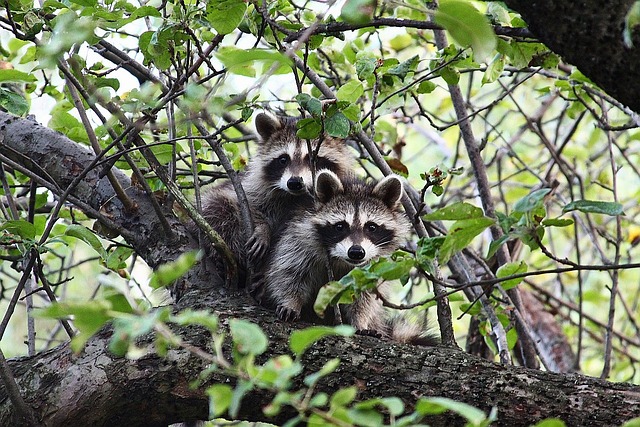Have you ever glanced out of your window or ventured into a park and spotted a raccoon high up in a tree? If you have, you’ve likely asked yourself the same question I did: Can raccoons really climb trees?
Yes, raccoons are skilled climbers. Their sharp claws and agile bodies enable them to ascend trees with ease, making them excellent tree climbers.
Raccoons, with their masked faces and nimble paws, have a certain mystique about them. In this article, I’ll uncover the arboreal abilities of raccoons. I’ll explore their innate instincts, physical attributes, and real-life examples to determine whether raccoons are truly adept tree climbers. So, let’s dive in and discover the secrets of raccoons in the treetops!
The Basics of Raccoons
Before I delve into the specifics of raccoons’ tree-climbing prowess, let’s get to know these intriguing creatures a bit better.
Raccoon Identity: Raccoons, scientifically known as Procyon lotor, are small to medium-sized mammals native to North America. They are instantly recognizable by their distinctive features, including a black mask-like pattern around their eyes and a ringed tail, which has earned them the nickname “masked bandits.” Their fur is typically grayish, but it can vary depending on their habitat.
Nocturnal Wonders: Raccoons are primarily nocturnal, meaning they are most active during the night. This nocturnal behavior is one reason why you might spot them climbing trees during the evening hours, as they search for food and explore their surroundings under the cover of darkness.
Adaptation Masters: Raccoons are highly adaptable creatures. While they are commonly associated with forests and wooded areas, they have successfully adapted to urban and suburban environments. They are opportunistic omnivores, which means they’ll eat just about anything, from fruits and insects to small mammals and scavenged human food.
Curiosity and Dexterity: One of the most endearing traits of raccoons is their insatiable curiosity. They are known for using their front paws almost like hands, which allows them to manipulate objects, open containers, and even turn doorknobs—a skill that has earned them a reputation as crafty scavengers.
Now that you’ve introduced the basics of raccoons, you’re better prepared to explore their tree-climbing abilities. These little masked bandits have more surprises in store, and it’s time to uncover their arboreal secrets.
The Arboreal World of Raccoons
Raccoons may not be known as dedicated tree-dwellers like some other animals, but trees play a significant role in their lives. Let’s dive into the fascinating arboreal world of raccoons:
The Climbing Instinct: Raccoons are natural climbers. Their powerful and flexible limb muscles, combined with sharp claws, make them adept at scaling various surfaces, including trees. This instinctual climbing ability serves them well in their quest for food, safety, and exploration.
Urban Jungle Gym: Interestingly, raccoons have adapted remarkably well to urban and suburban environments, turning our neighborhoods into their playgrounds. Trees in these settings provide not only a refuge but also a strategic advantage. Raccoons often use trees to evade predators and access food sources like bird nests and fruit-bearing branches.
Raccoons as Foragers: Trees are essential in the raccoon’s quest for sustenance. They are omnivorous creatures with a diverse diet, and trees offer a smorgasbord of opportunities. From raiding bird nests for eggs to feasting on fruits, nuts, and insects in the canopy, raccoons employ their tree-climbing skills to secure a meal.
Hunting and Shelter: Raccoons are excellent tree climbers when it comes to hunting and seeking shelter. They can scale trees to stalk their prey, such as squirrels or nesting birds. Additionally, raccoons occasionally nest in tree hollows or cavities, providing a safe haven from ground-level threats.
The arboreal realm isn’t the raccoon’s primary residence, but it’s an integral part of their lifestyle. Their ability to navigate trees with agility and precision is a testament to their adaptability, curiosity, and resourcefulness.
Can Raccoons Really Climb Trees?
The short answer is a resounding yes, raccoons are exceptional climbers. Their tree-climbing abilities are a testament to their remarkable physical attributes and natural instincts. Let’s delve deeper into why raccoons are such adept tree climbers:
The Claws That Conquer: Raccoons have sharp, curved claws that are perfect for gripping onto various surfaces, including tree bark. These claws allow them to anchor themselves securely as they ascend and descend trees. It’s akin to having built-in climbing gear.
Balancing Act: Raccoons possess incredible balance and agility. Their strong hind legs and long, bushy tails aid in maintaining stability while navigating branches. This balance is crucial, especially when they’re moving around in the treetops at night, where visibility is limited.
Tree-Dwelling Raccoons: While raccoons primarily use trees for hunting, foraging, and evading predators, they have been known to make themselves at home in tree hollows and cavities. These natural shelters provide safety and insulation from the elements.
However, it’s essential to note that while raccoons are impressive climbers, there are some limitations to their arboreal adventures:
- Size Matters: Larger raccoons may find it slightly more challenging to climb trees compared to their smaller counterparts. Trees with thinner branches may not support their weight as effectively.
- Obstacles and Techniques: Raccoons are skilled at navigating tree trunks and branches, but they may face difficulties with certain obstacles like dense foliage or exceptionally smooth bark. In such cases, they employ their dexterity and problem-solving skills to find alternative routes.
- Nesting and Reproduction: Raccoons typically prefer nesting on the ground or in dens, especially when they’re raising their young. While they may use trees as occasional hideouts, they aren’t known for constructing elaborate nests in the canopy.
In summary, raccoons are indeed excellent climbers, and their tree-climbing abilities are a testament to their adaptability and resourcefulness. While they may not be full-time tree-dwellers, their proficiency in ascending trees allows them to access food, avoid danger, and thrive in diverse environments.
Tree Climbing Challenges
While raccoons are undeniably skilled climbers, they do face several challenges when navigating trees. Understanding these challenges gives us insight into the incredible adaptability and problem-solving abilities of these animals:
- Size Matters: Raccoons come in various sizes, and their ability to climb trees can be influenced by their weight and body proportions. Larger raccoons may find it more challenging to navigate thinner branches, which might not support their weight as effectively. Smaller raccoons tend to be more agile in the treetops.
- Obstacles and Techniques: Trees are not always a raccoon’s playground. Dense foliage, particularly on deciduous trees during the summer months, can create challenges. However, raccoons are resourceful and will often use their dexterity to move through branches and find alternative routes. Their sharp claws and strong limbs help them tackle obstacles.
- Bark Texture: The texture of tree bark can vary significantly between tree species. Some trees have smooth, slippery bark that might pose a challenge for raccoons trying to climb vertically. In contrast, trees with rougher bark offer better traction. Raccoons adapt their climbing techniques depending on the type of tree they encounter.
- Nesting and Reproduction: Raccoons are known to nest on the ground or in dens, especially when they’re raising their young. During this period, they might avoid treetop adventures to protect their vulnerable kits. However, they may still use trees as temporary shelters or lookout points.
- Daylight Hours: Raccoons are primarily nocturnal animals, which means they do most of their tree climbing under the cover of darkness. Their night vision and heightened senses help them navigate trees safely. During the daytime, they may choose to rest in tree branches or hollows to avoid potential predators.
In the face of these challenges, raccoons showcase their adaptability and problem-solving abilities. Their keen senses, sharp claws, and innate curiosity enable them to overcome obstacles and make the most of their tree-climbing endeavors.
Real-Life Examples
Raccoons are not only skilled climbers, but they are also incredibly resourceful and adaptable in their pursuit of life in the treetops. Here are some real-life examples and stories that highlight their arboreal prowess:
- Urban Acrobats: In urban and suburban areas, raccoons have earned a reputation as “urban acrobats” due to their impressive climbing abilities. It’s not uncommon to spot raccoons scaling fences, trees, and even the sides of buildings. These agile maneuvers allow them to access food sources and evade potential threats, all while blending seamlessly into the urban landscape.
- Birdfeeder Bandits: Birdwatchers and backyard enthusiasts often share stories of raccoons raiding bird feeders perched high in trees. Their climbing skills, coupled with their insatiable appetite for seeds and suet, make them formidable contenders in the world of birdfeeder heists.
- Fruity Feasts: Raccoons are known for their fondness of fruit. Orchards and backyard fruit trees are prime targets for these crafty critters. They effortlessly climb trees to reach the sweet, ripe fruit hanging from branches. It’s not uncommon for homeowners to find evidence of raccoon visits in the form of half-eaten apples or peaches.
- Nesting High: Raccoons are opportunistic when it comes to nesting sites. They might choose tree hollows or cavities high above the ground to give birth and raise their young. This strategy offers protection from ground-level predators and provides a safe haven for their kits.
- Squirrel Standoffs: Raccoons are skilled hunters and will sometimes climb trees to pursue their prey, such as squirrels. High-stakes chases between raccoons and squirrels among the branches are not uncommon, showcasing the raccoon’s agility and determination.
- Nighttime Tree-Dwellers: Observers have reported raccoons resting in tree branches during the daytime, particularly when they’ve been active throughout the night. These elevated perches offer a safe and hidden vantage point from which raccoons can survey their surroundings and remain vigilant.
These real-life examples underscore the versatility and adaptability of raccoons in their interactions with trees. From foraging for food to seeking shelter and even engaging in playful antics, raccoons make the most of their climbing abilities in a variety of situations. While their tree-climbing adventures may present challenges at times, their determination and resourcefulness often lead to successful outcomes in their arboreal endeavors.
Safety and Conservation
As you’ve explored the world of raccoons and their tree-climbing abilities, it’s important to consider both their safety and conservation in the context of our interactions with these fascinating creatures.
- Raccoons as Pests: While raccoons are undeniably clever and adaptable, their presence in urban and suburban areas can sometimes lead to conflicts with humans. They are notorious for rummaging through trash cans, raiding gardens, and even taking up residence in attics. To mitigate these issues, it’s essential for homeowners to secure their garbage and seal potential entry points to prevent raccoons from becoming unwanted guests.
- Human-Raccoon Coexistence: It’s crucial to strike a balance between coexisting with raccoons and addressing conflicts that may arise. Educating oneself and others about raccoon behavior and employing humane deterrents can help prevent confrontations and ensure peaceful coexistence.
- Conservation Efforts: Raccoons, like many wildlife species, face habitat loss due to urbanization and other human activities. Conserving natural habitats and creating wildlife corridors can help raccoons and other animals maintain their ecological roles in our ecosystems.
- Ethical Tree Maintenance: When it comes to trees, it’s important to practice responsible tree care. Trimming branches should be done thoughtfully, considering the potential impact on wildlife, including raccoons. Avoid removing trees that serve as vital shelter or food sources for these animals.
- Wildlife Rehabilitation: In situations where raccoons are injured, orphaned, or in distress, it’s essential to contact local wildlife rehabilitation centers or authorities. These organizations can provide the care and support needed to help raccoons return to their natural habitats.
- Legal Considerations: Laws and regulations regarding raccoons vary by region. It’s crucial to be aware of local wildlife protection laws and to respect them. Unauthorized trapping or relocation of raccoons can have unintended consequences and may be illegal.
Raccoons are remarkable creatures with an array of talents, including their impressive tree-climbing abilities. While they are known for their adaptability and resourcefulness, it’s essential for us to respect their role in our ecosystems and take measures to coexist peacefully with them.
Conclusion
In conclusion, can raccoons really climb trees? The resounding answer is yes! Their sharp claws, agile bodies, and innate curiosity make them exceptional climbers. They tackle challenges, adapt to various environments, and leave their mark as urban acrobats and skilled hunters in the treetops.
As you’ve seen, raccoons bring both wonder and challenges to our lives. They can be resourceful foragers, but they may also venture into our gardens and trash cans. Striking a balance between coexistence and conflict prevention is crucial for both their safety and ours.
Conservation efforts play a vital role in preserving raccoon habitats and ensuring their place in our ecosystems. By respecting wildlife protection laws, practicing ethical tree maintenance, and supporting wildlife rehabilitation, we can contribute to the well-being of these charismatic masked bandits.
In the end, raccoons are a testament to the resilience and adaptability of wildlife in our ever-changing world. Their tree-climbing adventures serve as a reminder of the rich tapestry of nature that surrounds us, even in the heart of our urban environments.
So, the next time you spot a raccoon perched high in a tree, take a moment to appreciate the incredible skills and stories these animals bring to our shared landscape.
Here is another great question many ask: Can Raccoons Be Domesticated?










